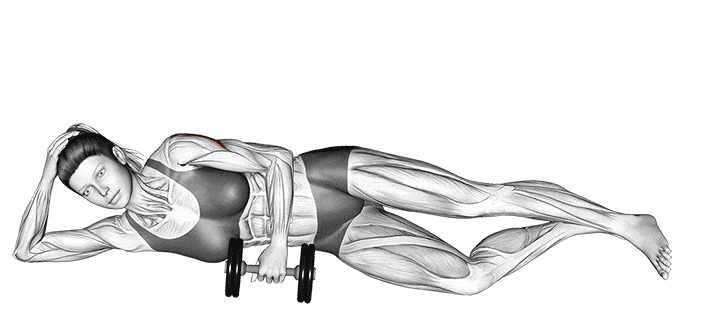5. Side-Lying External Rotator Is One of the Best Shoulder Impingement Exercises
This technique is easy to perform and can help to stabilize and strengthen your rotator cuff muscles used for rotating the arm outward. Other benefits include increasing scapular movement and reducing the risk of reinjury.
To do the side-lying external rotator:
1. Lie down on a hard flat surface and on the opposite side of your injured arm.
2. Your knees should be together. Prop your head with your other arm.
3. Hold a light dumbbell with your injured arm.
4. Bend the elbow of the arm holding the dumbbell to a 90-degree angle between your upper arm and forearm.
5. Rest your elbow on your side with your forearm resting across your abdomen.
6. With your elbow against your side, slowly raise the dumbbell toward the ceiling in a semi-circular or external rotation motion.
7. Ensure you are not rotating your arm too far back. Stop rotating your arm if you feel a strain.
8. Once you’ve reached the comfort level, hold the posture for 2-3 seconds before bringing your arm down to the starting position.
9. Repeat 3 sets of 10 up to 3 times per day.
10. Consider increasing to 20 reps when a set of 10 becomes easy.
You may perform the exercise on your uninjured shoulder for balance. Also avoid using a heavy dumbbell as it can lead to rotator cuff injury.
Physical Therapy for Shoulder Impingement
Remember that these five best exercises for shoulder impingement may not replace a physical therapy rehabilitation program by a certified therapist. Physical therapy is a complementary non-surgical treatment commonly prescribed for impingement of the shoulder. It can help those recovering from shoulder injury or impingement syndrome get extensive relief. Your therapist may use therapeutic modalities that are personalized to suit your needs. The long-term goals include helping you regain maximum shoulder function, shoulder flexibility, and strength.
With targeted rehabilitative exercises and home-based exercises, you can recover and get back to work, athletic activities, and be able to perform daily tasks at ease.



